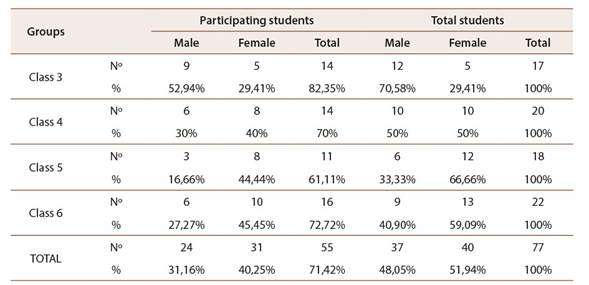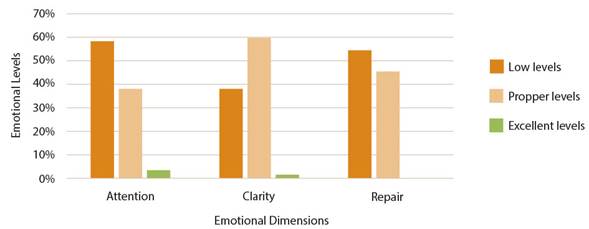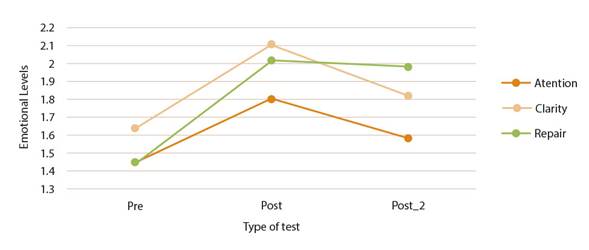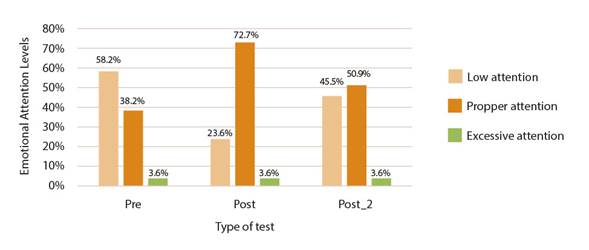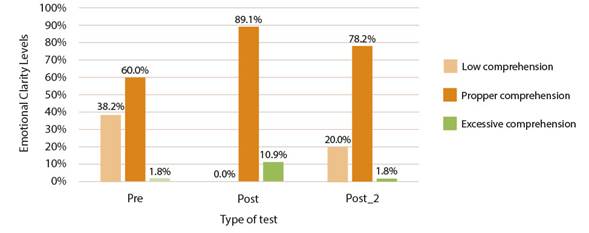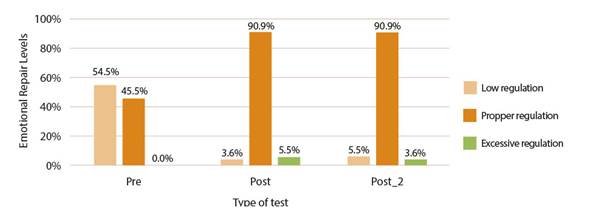Introduction
Thanks to the transformation of teaching models, the development of emotional competence is quite present in schools and teachers often pay great importance to it. However, the application of effective emotional programs in the classroom continues to pose an educational challenge that few teachers are prepared to face. Though, it is necessary to work in the classroom with emotional competences, to make students able to succeed in their future. Creative and artistic subjects have proven to be effective in teaching emotional and social skills (Extremera Pacheco & Fernández Berrocal, 2005) but are not worked enough in the classes.
The present research is based on the need to educate emotionally through the artistic subjects students in situations of vulnerability. This study was held in a school in the outskirts of Albacete (Spain) in a marginal neighborhood of the city. The socioeconomic profile of the neighborhood’s population is very disadvantaged. A high percentage of the people are illiterate. School failure and dropout is very high. A high percentage of the population is unemployed. Many depend on government incomes and social employment (Brown et al., 2013). There is a significant drug problem in the neighborhood. There are very high levels of school failure and dropout (García López & Villar Cortés, 2011). The objective was to train the students of a vulnerable background to notice, understand and manage their emotions, through music and visual arts, using these means as tools to promote a better quality of life for themselves and their environment.
Emotional Intelligence (EI) is an umbrella term that can be understood in different ways. One of the most accepted is the one conceiving it as a capacity that encompasses different skills that human beings practice in an intrinsic way and in their interpersonal relationships. The rise of EI begins with the Emotional Intelligence study of Salovey and Mayer (1990). In the same decade, the book Emotional Intelligence (Goleman, 1995) popularized the concept. At the beginning of the 21st century, EI turns out to have a growing prestige, both in the psychological and educational aspects, counting with many researches on the field and the emergence of new teaching models.
In the emotional education iterventions, resilience must be promoted as an ability to develop psychologically in a successful way. This has to be achieved despite of being born and raised in risky environments (Rutter, 1993). One of the first researches on resilience was a longitudinal study by Werner and Smith (1982), which showed that a wounded child is not necessarily condemned to be a failed adult (Vera Poseck et al., 2006). Thus, resilience is a useful and beneficial tool to work with students of these characteristics (Acevedo & Restrepo, 2012). Working on resilience and emotional competence in educational contexts reduces the possibilities of health problems. These benefits imply both physical and mental aspects. Early school dropout can also be prevented, opening a path of hope for many children living in conditions of vulnerability and disadvantage.
The program analysed in this research consisted of a series of sessions, in which the pupils were intended to know and learn emotional education strategies to apply in their daily lives. To this end, a booklet was developed as a resource to learn basic emotions, in their dimensions of attention, clarity and repair (evaluated by the TSM-24 questionnaire). To work on the booklet, certain works of art and melodies were selected that helped evoke the emotions we wanted to tackle. The activities in the booklet were intended to work on attention, clarity and repair of each of the emotions, thanks to the artistic and musical activities.
Multimedia presentations were projected on the digital board to work on emotions. In the first session the pretest was passed, in the following sessions the pupils worked with the booklet and in the last session the post-test was passed again. After three weeks, the contrast post-test was passed again.
Objectives
The main objective was to improve the EI of students belonging to vulnerable contexts through artistic activities in Primary Education.
Subsequently, three general objectives were set:
To verify the existing relationship between Emotional Intelligence and arts in students of Primary Education in disadvantaged contexts.
To evaluate the emotional quotient of the students through the results of the pre-post-test in the dimensions of attention, clarity and emotional repair.
To assess the effectiveness of the didactic intervention in the students three weeks after finishing it by means of a delayed post-test.
Method
The didactic artistic-musical emotional intervention focuses on the emotions, feelings and values that were intended to transmit to the students. It included the reading of the book about emotions ‘Emocionario’ (Núñez & Romero, 2013). Additionally, a series of melodies and songs were chosen for the program. A first contact was maintained with all the students at the school, which based mainly on observation. After this initial stage, four classes were selected to focus the didactic intervention on the work of eight emotions: sadness, joy, anger, serenity, fear, amazement, envy and gratitude. The choice was made due to the lack shown by many of the students concerning the attention, expression and management of these emotions.
Similar research can be found in the work of Morales Rodríguez (2017), studying the relationships between coping with daily stress, self-concept, social skills and emotional intelligence in Secondary Education students.
The didactic approach of the proposed sessions consisted of selecting an emotion and its opposite. Thus, we worked with an emotion, with its definition, and it was accompanied with a melody, an image and different reflexible activities, aiming their identification, classification and proper management by the students. The activities of the programme aimed to develop the emotional content, linked to the visual arts and music. This was done through a work booklet that each student performed individually. Subsequently, they exchanged their ideas, and held debates, to share with the rest of their peers their emotions, feelings, experiences, experiences, memories, etc. in order to promote social and communication skills, such as respecting the turn of speech and oratory.
Participants
The research was carried out with Primary Education students in a school of a neighborhood in the city of Albacete (Spain), with high levels of marginality and social and cultural models, characterized by low or no formal training and rigid patterns of behavior and conflict resolution. The neighbourhood has approximately 2,400 inhabitants. Most of the families face situations of marginality and risk of social exclusion, due to dysfunctions in socio-family dynamics, precarious economic backgrounds and health problems. All these circumstances made the students at the school especially vulnerable, being necessary a socio-educational intervention. The school is integrated in a multidisciplinary project, collaborating with different entities in the neighborhood, such as school, families and social services. This project is called learning community, a programme implemented in some Spanish schools (Fuensanta Casado & García López, 2017).
Regarding the academic issues, the teachers of the school gave priority to the teaching of functional contents, with the purpose of training their students as individuals with values, responsible, tolerant and well behaving. The academic level achieved by the students tends to show low results, generally. The classroom climate, in relation to the emotional and physical aspects is usually good, being welcoming and promoting confidence and integration in the group, since when conflicts arise teachers spend a lot of class time solving them.
Initially, the participants of the study were 77 students of 3rd, 4th, 5th and 6th grade of Primary Education, with 48.05% of males and 51.94% of females, whose age range ranges from 8 and 13 years old. As a consequence of the school’s high absenteeism rate the number of participants was finally reduced to 55, with 43.63% males and 56.36% females. The choice of experimental groups was non-probabilistic, also known as intentional sampling, using age as a selection criterion. The total number of students per primary education (PE) course and students participating in the study is shown in Table 1.
Design
The research has followed a quasi-experimental and intra-subject type design, as the subjects were not randomly selected and three measurements were made (pretest, post-test and post-test deferred), to assume the causal relationship between the comparison of the response variable before and after the exposure of the subjects to the experimental intervention. The comparisons were made between the treatment performed on the same experimental group of subjects. The data collection was carried out at three different moments of the research, having also a short-term longitudinal approach.
Shared-type categories were used, characterized by attempting to know the attitudes, values, knowledge and beliefs about the emotional education of several members of the social system studied. Patterns of relational type and human development were also followed, given that the links between individuals and personal improvement represented an important aspect in this research (Hernández Sampieri et al., 2014).
Instruments
To cover the objectives of the study, a quantitative instrument was applied to measure the emotional variables, specifically a questionnaire, in order to collect data about the students’ EI at three key moments: at the beginning of the intervention, at the end of it and after three weeks.
Salovey et al. (1995) developed an instrument in 1995 with the purpose of evaluating the meta-knowledge of emotional states through 48 items, the Trait Meta-Mood Scale (TMMS-48). There is a reduced and modified adaptation to Spanish of the original English version, which was the one used with the subjects of the research, the TMMS-24 questionnaire (Fernández Berrocal et al., 1998). This reduced adaptation of the initial scale contains 24 items, which are divided into groups of 8. Each of these groups corresponds to the three dimensions that assess the knowledge and beliefs that subjects have about their ability to attend and monitor their emotions and feelings ( Fernández Berrocal & Extremera Pacheco, 2005). These dimensions are considered key features in EI. The first dimension corresponds to emotional attention, which implies to understand and label their emotions. The second dimension measures the emotional clarity, which refers to how people believe they perceive their emotions. The third dimension measures the emotional repair, which refers to the ability to regulate negative emotional states and extend positive ones.
The items are presented with simple statements. Through a Likert scale the subjects indicate the degree to which they agree with the statements, which ranges from 1 (no agreement) to 5 (totally agree). Regarding the reliability of each component, Extremera Pacheco and Fernández Berrocal (2005) establish the following values checked through Cronbach’s Alpha: attention (α = .90); clarity (α = .90) and repair (α = .86). In the same way, it presents adequate test-retest reliability: attention (α = .60); clarity (α = .70) and repair (α = .83).
Procedure
The research was conducted with the students of four courses of Primary Education, from 3rd to 6th class (aged 8 to 12 years old), at a school of primary education in Albacete (Spain), located in a disadvantaged neighbourhood in the outskirts of the city.
The timing consisted of 16 sessions per group, held for two months, between the second and third terms of the school year 2017/2018. Before starting with the activities of the program, the TMMS-24 questionnaire was provided to the participants in the study. They answered it anonymously. In the evaluation, the established scale was considered for each dimension, taking into account the differences between the sexes.
The activities carried out followed a didactic sequence of 16 sessions, divided into 2 weekly sessions, with an average duration of 60 minutes each. They were designed with a ludic nature, related to the musical, artistic and emotional theme, to achieve the previously established objectives.
In the first session, each pupil signed an individual contract where they agreed on doing the activities of the music and emotions workbook, learning about music genres and emotions, as well as having fun with their classmates and learning to live in a more joyful way. The following emotions were worked out: sadness, happiness, anger, fear, serenity, astonishment, envy, jealousy and gratitude. The sixty-minutes sessions followed a series of steps. First, the pupils listened to a piece of music. After finishing it, they made a reflection on the emotions that it produced in them. After this, the teacher introduced the genre, instruments and other information about the listening. In the next step the pupils listened to the description of the corresponding emotion. After this, they watched at the emotion in the emotion book (emocionario) and analysed it. This was presented normally with a piece of art. In the last step the made activities to identify, attend and manage properly each emotion. The activities were flexible and with a playful, creative and emotional character, thanks to the musical and artistic elements that helped the manifestation of emotions progressively.
Results
The TMMS-24 questionnaire evaluated different emotional dimensions: attention (items 1 to 8), clarity (items 9 to 16) and repair (items 17 to 24). The score of each dimension is interpreted following Fernández Berrocal et al. (2004), as shown in Table 2. The scores are disaggregated by gender.
Table 2: Interpretative scores of the TMMS-24 granted by the authors
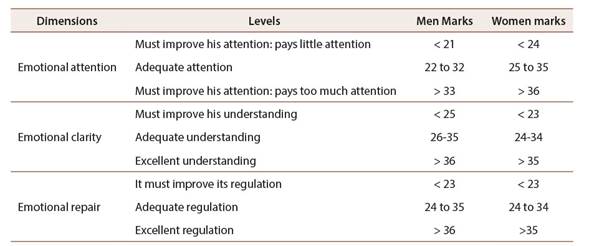
Note: Own elaboration, based on Fernández Berrocal et al. (2004).
In the analysis of the levels of students in TMMS-24 pretest (Figure 1), the results of Cronbach’s Alpha turned out to be adequate: emotional attention (α = .82), emotional clarity (α = .69) and emotional repair (α = .73). Therefore, according to these data, it can be affirmed that the questionnaire is an adequate instrument, since it indicates a good level of internal consistency.
The Spearman non-parametric type correlation coefficient test was applied to check if there was a significant linear relationship between the pretest scores of each emotional dimension of the questionnaire. This was made to calculate a correlation coefficient to evaluate the relationship between the pretest scores in the dimension of attention, clarity and emotional repair.
The results show that there is a statistically significant correlation between the attention dimension and emotional clarity (rs = .402, p = .002). The same occurs between the emotional attention and repair factor, since the correlation coefficient indicates that there is a statistically significant relationship between these variables (rs = .283, p = .036). The correlation coefficient between the dimension of emotional clarity and emotional regulation also shows a statistically significant relationship (rs = .283, p = .036), therefore, it can be affirmed that there are statistically significant relationships among all the variables of the questionnaire.
In order to confirm if there were statistically significant differences among the three measurements for each of the variables, Friedman’s nonparametric test was used. The results show that there are statistically significant differences between the pre-post-test (X 2 ( 2) = 16.32, p <.001), deferred pre-post-test (X 2 (2) = 4.93, p = .001) and post- deferred post-test (X 2 (2) = 12.76, p <.001) for each one of the variables.
It can be affirmed that the emotional level of the students is markedly different before the artistic-musical intervention and after finishing it and also three weeks after the training.
The scores between the first two data collections (pre-post) were analyzed through the Wilcoxon signed rank test. By the level of significance (p <.001), it can be verified, that there are remarkably significant differences between the EI level of the subjects before and after the emotional-didactic intervention in each of the dimensions of the questionnaire. Additionally, the effect size between these two measurements, for emotional attention (r = .53), emotional clarity (r = .66) and emotional repair (r = .72) the effect appears to be quite relevant.
After the analysis of the post-test and the delayed post-test through Wilcoxon, the level of significance in attention (p = .001) and emotional clarity (p <.001) shows differences in these dimensions three weeks after the measurement of these variables, as the values have decreased. However, in the emotional repair factor, this level of significance does not show that there are statistically significant differences between the two tests (p = .480), so it indicates that it is the emotional dimension that has remained more stable with the passage the time. Respecting the size of the effect, it can be observed that in both, emotional attention (r = .43) and emotional clarity (r = .53) the effect was bigger, due to the small change that the values had undergone compared to the dimension of emotional repair (r = .09) whose data in the tests show that apparently there is no effect on the scale, since the values remained practically stable after three weeks.
Finally, deferred pre-post-test scores were studied in order to observe the evolution of the values throughout the time, after the didactic intervention and to check whether there were significant differences between these two measurements. The non-parametric test, used to compare the samples was the Wilcoxon test. The results indicate that between the pretest and the post-test, there were statistically significant differences in the factors of clarity (p = .025) and especially in emotional repair (p <.001), whose levels indicate an improvement by the students. in these two dimensions. In contrast, in the emotional attention factor no significant differences were found in these two measurements (p = .162), which indicates that it is least developed dimension, although the results are more positive in the post-deferred post-test than at the beginning of the investigation. On the other hand, the values shown by the effect size test show that in these data the effect in the emotional attention dimension is small (r = .18), while in the dimension of clarity it is in the intermediate levels (r = .30) and in the emotional repair the levels achieve a remarkably large effect (r = .70). The score distribution with respect to the emotional dimensions of the questionnaire in the different moments in which the students were evaluated can be observed in the following graph.
Regarding the graphical pretest-posttest-posttest deferred scores TMMS-24 (Figure 2), in the three factors of attention, clarity and emotional repair, the levels are lower at the beginning of the research, increase at the end of the didactic intervention and, finally, tend to decrease over time as reflected by the deferred post-test.
Discussion
The EI factors evaluated in this study, attention, clarity and emotional repair, refer to self-reported items, that is, to the perception of the subjects themselves about their EI levels and not to a real emotional ability test (Mayer, 2001). Therefore, the results have shown to be significant since an improvement in the evaluated scales has been observed through the key instrument of the study, the TMMS-24. This test has shown a remarkable increase in the values presented by the subjects. For this reason, it can be affirmed that EI is closely related to art, due to the success of the intervention in terms of the development of the aforementioned emotional dimensions.
The pretest shows that the students tend to describe and distinguish their emotions but do not excel in the ability to reflect on them, identify them at the right time and regulate the emotional reaction produced.
Three weeks after the intervention finished, the students were re-evaluated with the same questionnaire through a delayed post-test. In general, the results were lower in this last data collection, in comparison with the previous one, but it is noteworthy that the students showed higher emotional levels than in the pretest.
The data reveal again that emotional attention is the dimension with lower scores, with an important decrease between the second and third data collection, being the least developed factor during the study. On the other hand, although emotional reparation does not reach high scores, it is the only dimension that manages to maintain its levels stable over time. The emotional clarity obtains very high scores in the second data collection that decrease in the last evaluation.
Therefore, emotional repair is the factor that presents most significant changes. In the pretest, this scale shows values below the average that manage to increase and maintain with the passage of time. However, the other two dimensions, in spite of presenting lower levels between the post-test and the deferred post-test, point out that most of the students are in the emotional mean indicated by the creators of the questionnaire. In addition, in the last data collection, their levels continue to be above the values of the first measurement. Thus, we can affirm that there has been a development of the EI through the artistic-emotional intervention.
With regard to the relationship of the emotional attention dimension with the rest, the results coincide with one of the first investigations carried out in Spain using this measure, the study by Fernández Berrocal et al. (1999) where the emotional variables correlated among each other and the emotional attention scale showed positive correlations with emotional clarity. From this it follows that, in general, persons who tend to attend to their emotions will not have so many difficulties in differentiating them properly.
We can observe that this dimension has the lowest levels compared to the other two scales. In the pretest, more than half of the participants indicated paying little attention to their emotions and feelings, since the levels mostly show low attention, compared to 38.2% of students that presents adequate levels. According to Gohm (2003) the low results on this scale characterize the participants as people who do not take into consideration their affective states and are not competent in the regulation of their emotions, since they do not usually employ emotional attention strategies. In the second data collection, at the end of the didactic intervention, the results showed remarkable differences. This time, most of the subjects presented adequate levels of emotional attention, specifically 72.7%. These scores are very positive, since they indicate that, in general, students tend to use more adaptive emotional regulation strategies when they know how to use the information obtained from their emotions in their social relationships (Gohm, 2003). Despite these positive data, 23.6% of students continue to show a lower level on this scale. In the last data collection, the percentage of students with low levels of emotional attention increases, reaching 45.5%, and as a result, the percentage of students that had adequate levels in this scale decreases.
On the other hand, regarding the graphical emotional attention scores of the students TMMS-24 (Figure 3), it is interesting to note that 3.6% of the subjects show excessive emotional attention during the three data collections. According to studies carried out by Nolen-Hoeksema et al. (1999) these students could have consequences in their future related to the increase of anxious and depressive moods. Individuals with high levels of attention, in addition to suffering from depressive symptomatology and anxiety, usually present a greater number of physical symptoms (Extremera Pacheco & Fernández Berrocal, 2005).
The dimension referred to emotional clarity (emotional comprehension), analyzes the ability of subjects to understand emotions and feelings. It is the highest score obtained in the pretest, with levels of 60%, indicating an adequate emotional understanding of the students compared to 38.2% with lower levels. In the post-test, very significant figures were achieved: 89.1% of the sample reported having adequate levels compared to 10.9%. These results are very positive, since, apparently, there are no students with low scores in emotional clarity and the scores obtained suggest that they are individuals prone to have some emotional well-being, as they become more skilled in the resolution of emotional conflicts.
In the last data collection, 78.2% continues to show an adequate emotional understanding, while the number of students who must improve on this scale increases to 20%. Levels of excellence in emotional comprehension, only reached a tiny percentage of students.
The evolution of emotional clarity ratings TMMS-24 is shown in Figure 4.
The emotional repair dimension shows in the pretest that 54.5% of the participants have low emotional regulation. In the second data collection, the results increase remarkably until 90.9% of the subjects who indicate having abilities to be able to regulate their emotional states, while 3.6% show the opposite, while a minority indicates having a excellent regulation. In the deferred post-test, the number of students that presents adequate values in this dimension continues to remain unchanged, while the number of participants with excellent levels is reduced and the subjects with low levels in this scale increase minimally.
Among the different components of EI, emotional repair has been one of the most significant scales of the study. The graphical emotional repair scores TMMS-24 evolution is shown in Figure 5. The level of adequate regulation has increased significantly in the last data collection compared to the pretest, showing a relevant level of the effect, which shows that the students have perfected their emotional competence, especially in the skills of regulation and control of emotions. Likewise, this factor has been the most stable after the intervention ended, showing no differences between the post-test and the deferred post-test, as students have been able to maintain the values efficiently.
Conclusions
Teaching based on knowing how to reflect, having empathic and creative skills, making decisions, judgments, knowing, expressing and controlling emotions effectively, among others, happens to be basic in our educational system. In this sense, artistic and creative subjects, in addition to enhancing intellectual abilities, awaken the most sensitive side of students and help them develop emotional competence by allowing them to express and understand emotions through different artistic activities (music, poetry, image).
As the results of this study have shown, the implementation of programs where the students can work on the different dimensions of their emotions can be especially useful in vulnerable social backgrounds. The statistical analysis of the data has revealed significant differences before and after the intervention at school, even after the second post-test, carried out weeks after finishing the experience. Statistically significant differences appeared especially in the factors of clarity and emotional repair, showing a clear improvement by the students in these two dimensions. Following Fernández Berrocal and Extremera Pacheco (2005), the application of this quasi-experimental design, based on the Mayer and Salovey (1997) skill model, has allowed verifying with a simple pretest-posttest intervention that the program has been effective.
The use of the TMMS-24 scale has been a valuable resource for the data collection and helpful to clarify tha aspects to be measured. According to Fernández Berrocal and Extremera Pacheco (2005) this type of self-report measures is a suitable option to evaluate intrapersonal skills. Relying on introspection allows us to assess underlying emotional processes, as we have done in this study. The benefits of this program, using arts and music, focusing on activities to recognize, analyse and control the emotions, could be extended to other schools in marginal social backgrounds.
According to the results, we can affirm that the main objective of the intervention (to improve the EI of students belonging to vulnerable contexts) was achieved. Similarly, the relationship between EI and Art in students of Primary Education in disadvantaged contexts could be verified. In addition, the emotional quotient of the students through the results of the pre-post-test in the dimensions of attention, clarity and emotional repair could be evaluated. Likewise, the effectiveness of the didactic intervention could be assessed with a deferred post-test.
Consequently, it is necessary to implement socio-educational measures that include emotional content in the schools, so that children who go through difficult situations can overcome negative emotions. The school is a fundamental framework for emotional teaching, where children interact constantly with their peers. However, the main context of emotional development is the family environment. In this space, children learn social and emotional strategies through constant bidirectional connections with their parents and other family members. Unfortunately, not all family environments have satisfactory characteristics for children to develop their emotional competence properly. In this sense, schools and teachers must help overcoming the difficult circumstances that some children go through. As we have seen in this study, EI can be an effective tool to face these situations, balancing the negative effects of adversity, favoring learning and strengthening resilient capacity, regardless of the family, social and cultural origin of the students.














